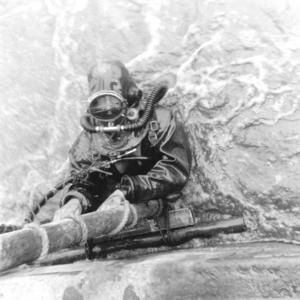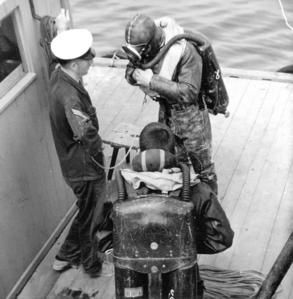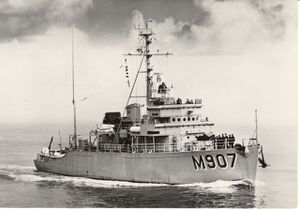Le vêtement à volume constant (VVC) a progressivement remplacé l'équipement du pied-lourd.
Le vêtement à volume constant (VVC) a progressivement remplacé l'équipement du pied-lourd.
 After leaving the Navy and the Clearance Divers Group, I worked during a few years for a diving company based in Brussels and there, I learned some of the basics of civil engineering diving which incidentally was quite different from military diving.
After leaving the Navy and the Clearance Divers Group, I worked during a few years for a diving company based in Brussels and there, I learned some of the basics of civil engineering diving which incidentally was quite different from military diving.
Then in 1972, I was enticed away by another diving company after they had inspected one of my sites and had judged that I was not too bad and thus could make a good recruit.
My wage was higher than where I worked previously, but this was in part justified because here it was the habit to send a diver on construction job with only a non-diver tender and as such it was common to spend 5-6 hours in the water several times a week.
Thus, on 23 November of this same year, my boss sent us the tender and me, on a mud removal work under a quay wall.
Once on-site, we prepared and tested all the material, then I dressed myself with my constant volume suit and jumped in the water.
Everything went very well during the first 2 hours, and the work progressed well, until the moment where I felt that my air pressure began to decrease.
As at the time, we were not yet using dive communications, I seized my umbilical and sent a signal of 3 pulls to inform that I came back to surface but oddly I received no signal in return.
Fortunately, water was only 5 meters deep and I had no difficulty to come up without air.
Once at the surface, I hold myself to the suction hose of the pump, opened my hood window and started to shout after my assistant.
As I was still getting no answer, I began to think that he had a problem otherwise he would not have left me down without air.
I decided therefore to swim back to the ladder to see what was happening.
The ladder was about thirty meters away.
In normal circumstances swimming to there would have presented no difficulty, but actually I was without air and was much too heavy to swim with an open hood.
Result, the only solution I had was to drop my weight belt. Much lighter now I began to swim but after only a few meters I was blocked because my umbilical was stuck somewhere on the surface and I could no longer move forward.
Again, the only solution that was offered to me was to cut my umbilical.
Obviously, all divers know that a diving knife can be used to do anything, except to cut.
Finally I managed to cut it with some difficulties and I could now reach the ladder and come out of the water.
I was really anxious to know what had happened to my tender, but as soon as I had passed my head over the quay wall I saw his feet sticking through the window of the truck and I understood.
In fact, the bastard was sleeping and because of the noise generated by the water pump and the compressor supplying the air lift, he had not heard that the small diving compressor had stopped.
Of course, my first reaction was to knock him down and throw him in the water, but I soon had another idea.
I decided to hide away and wait to his wake up.
The poor guy must have be exhausted, because I still had to wait nearly an hour before he moved.
First of all, I saw him stretch his legs and arms then still sleepy look to the left and the right.
Finally the door opened and he appeared.
He immediately saw that the diving compressor was not running anymore but rather going immediately to the umbilical, he tried first to restart it twice but without success, and then finally he came at the edge of the quay and took up the slack of the umbilical.
I was too far to see his reaction but I imagine he must be surprised to find that there was no one at the end of it and I suspect that his hands were shaking a bit. He held the extremity of the hose in his hands during some seconds without any reaction and not knowing what to do.
As for me, I had seen enough and I decided to come back.
When he saw me, I could see a great relief on his face, he tried even to joke, but I wasn't in the mood for that.
After blowing him up I told him to check the compressor to see if he could repair it while I was going to repair my umbilical and make another weight belt.
Unfortunately the compressor did not restart.
That was a problem because I knew that my boss had planned to do this work in a single day and if I had to return to Antwerp to take another compressor the day would be lost.
On the same site, I had noticed that a few workers were busy making some demolition works with a gas cutting torch and an idea came to me.
As I had dived a lot with pure oxygen during my Navy time, I said to myself that as there were only a few meters of water, this could be the solution and so I went to borrow a bottle of O² from those guys and thus could finish my job in the planned time.
When I came back to the workshop, my boss praised me for my initiative and my salary was increased by a few francs.
I do not know why, but over the following days I had some lungs irritation.
As for the tender: He was fired shortly after that for lack of professionalism.
Conclusion:
Never make the same BULLSHIT.
Début de ma longue carrière de plongeur - scaphandrier
Photo : Mon premier volume constant

Après avoir quitté le Groupe des Plongeurs Démineurs, je travaillai pendant quelques années pour une entreprise de plongée basée à l’époque à Bruxelles et là, j’appris une partie des rudiments de la plongée TP qui soit dit en passant n’avait en fait pas grand-chose à voir avec la plongée militaire.
Puis en 1972, je fus débauché par une boite de plongée d’Anvers qui après avoir inspecté un de mes chantiers avait jugé que je n’étais pas trop mauvais et que je ferais une bonne recrue.
Mon salaire était plus élevé que là où je travaillais précédemment, mais ceci était en partie justifié car ici on avait l’habitude d’envoyer un plongeur sur chantier avec seulement un assistant non plongeur et de ce fait il était courant de passer 5 à 6 heures dans l’eau plusieurs fois par semaine.
Ainsi, le 23 novembre de cette même année, mon patron nous envoya le tender et moi, faire un travail de dévasement dans des caissons de mur de quai.
Une fois sur place, le matériel installé et testé, je m’équipai et me mis à l’eau.
Tout se passa très bien pendant les 2 premières heures et le travail avançait bien, jusqu’au moment où je constatai que la pression d’air du compresseur de plongée commençait à diminuer.
Comme à l’époque, nous n’utilisions pas encore le téléphone, je saisis mon narghilé et envoyai un signal de 3 coups pour dire que je remontais, mais bizarrement je ne reçus aucun signal en retour.
Heureusement, il n’y avait que 5 mètres d’eau et je n’eus aucune difficulté à remonter sans air.
Une fois en surface, je m’agrippai au flexible d’aspiration de la motopompe, ouvris la glace de ma cagoule et commençai à gueuler après mon assistant.
Comme je ne recevais toujours pas de réponse, je commençais à penser qu’il avait eu un problème, sans quoi il ne m’aurait pas laissé tomber sans air.
Je décidai donc de rejoindre l’échelle de quai pour voir ce qui se passait.
L’échelle se trouvait à environ trente mètres.
En temps normal, cela n’aurait présenté aucune difficulté de nager jusque là, mais dans le cas présent, j’étais sans air et j’étais bien trop lourd pour nager avec la glace de la cagoule ouverte.
Résultat, la seule solution que j’avais fut de larguer ma ceinture de plomb, mais après quelques mètres de nage je fus bloqué car mon narghilé était coincé quelque part en surface et je ne pouvais plus avancer.
A nouveau, la seule solution qui s’offrait à moi fut de couper mon ombilical.
Evidemment, tous les plongeurs savent qu’un couteau de plongée peut servir à n’importe quoi, sauf à couper.
Finalement après avoir pesté pendant quelques instants durant la découpe du narghilé je pus finalement rejoindre l’échelle et sortir de l’eau.
J’étais vraiment anxieux de savoir ce qui était arrivé à mon tender, mais dès que j’eus passé la tête par-dessus le mur de quai, je vis ses pieds au travers de la vitre de la camionnette et je compris.
En fait, le salaud était tout bonnement entrain de dormir et à cause du bruit de la motopompe et du compresseur alimentant l’air lift, il n’avait pas entendu que le petit compresseur de plongée s’était arrêté.
Bien entendu, ma première réaction fut d’aller lui foutre une beigne et de le jeter à l’eau, mais j’eus très vite une autre idée.
Je décidai de me cacher et d’attendre qu’il se réveille.
Le pauvre devait être épuisé, car je dus encore attendre près d’une heure avant qu’il ne bouge.
Tout d’abord, je le vis s’étirer et jeter un regard endormi à droite et à gauche.
Puis la portière s’ouvrit et il apparu.
Bien sur, il vit immédiatement que le compresseur ne tournait plus, mais plutôt que d’aller immédiatement vers le narghilé, il tentât d’abord par deux fois de le redémarrer mais sans succès, puis finalement il vint au bord du quai et reprit le mou du narghilé.
J’étais trop loin pour voir sa réaction, mais j’imagine qu’il devait être surpris de constater qu’il n’y avait plus personne au bout.
Il tenait le bout du tuyau bêtement en ne sachant que faire, quant à moi, j’en avais vu assez, et je me décidai à revenir.
Lorsqu’il me vit, je pus voir un grand soulagement sur sa figure, il essaya même de plaisanter, mais moi je n’étais pas d’humeur.
Après l’avoir traité de tous les noms, je lui dis de vérifier le compresseur pour voir s’il pouvait le réparer pendant que moi j’arrangerais le narghilé et me confectionnerais une nouvelle ceinture de lest à l’aide de quelques bouts de ferraille.
Malheureusement le compresseur ne voulait pas redémarrer.
Je savais que pour ce travail mon patron n’avait prévu qu’une seule journée de travail.
J’étais dès lors super embêté car si je devais retourner à Anvers pour reprendre un autre compresseur, la journée aurait été perdue.
Sur le même chantier, j’avais remarqué que des ouvriers étaient occupés à faire des travaux de découpage au chalumeau, dès lors, une idée me vint.
Comme j’avais pas mal plongé à l’oxygène pur pendant mon séjour au GPD, je me dis que comme il n’y avait que quelques mètres d’eau, cela pouvait être la solution et c’est ainsi que j’allai emprunter une bouteille d’O² chez les ouvriers et pus ainsi terminer le chantier dans les temps prévus.
Lorsque je revins à l’atelier, mon patron me félicita pour mon initiative et mon salaire fut augmenté de quelques francs.
Je ne sais pas pour quelle raison, mais au cours des jours suivants j’eus quelques problèmes d’irritation pulmonaire.
L’assistant lui fut viré peu de temps après pour manque de professionnalisme.
Conclusion :
- NE FAITES JAMAIS LA MÊME CONNERIE
- L’oxygène industriel n’est pas filtré.
- Les narghilés utilisés avec un compresseur de plongée peuvent être contaminés par de l’huile et donc être sujet à une inflammation accidentelle.
- L’oxygène peut être utilisé lorsqu’il est respiré calmement pour écourter les paliers, mais surtout pas en condition d’effort.

A long time ago in 1966 I was very proud to join the EOD diving team of the Belgian Navy and begin my career as a professional diver.
As one might imagine, the main mission of this unit was to retrieve old sea mines still scattered along our coasts...
To carry out these missions we were using the French semi - closed circuit DC55 which was a very reliable apparatus that we could use to 55 m with a nitrox mixture of 30/70.(you see that the upper PPO² limit was higher in those days).
At that time, we were only a few divers in service spread aboard 2 mine hunters based in Ostend. As I said, lot of mines were still discovered or caught in the nets of trawlers, and we were therefore obliged to always have a team ready to intervene at any time.
So on a certain date in June 1967 I was particularly happy because I was off duty for 3 days and I had planned to have good fun in the harbour of Ostend where our mine hunters were based.
As at that time I was a big partygoer, I spend all the night drinking, dancing and chasing the lovely English girls who came on the continent to have some fun with the smart divers we were.
That night I was aware that I had drunk a bit more than reason but didn't care because I thought I could sleep and recover during the next day.
Unfortunately for me, this was not the case as at 9 in the morning, the Chief diver entered the room and pulled me out of my bunk by telling me that I had 10 minutes to prepare my dive bag and leave for a mission with the stand by mine hunter.
I tried to explain him that I was off duty that day but he told me that the other watch diver was ill and that I was due to replace him immediately.
So I went on my feet, took my 3 mm neoprene wet suit and joined the other divers that were already on board of the Van Artevelde.

During the trip to the diving scene I tried to recover a bit from my heavy night.
I had a real hang - over and I therefore didn't bother to much about the diving gear I was going to use which I thought had already be prepared by the diving team on watch.
At 11 o'clock, the sonar technician told us that he had a contact 300 meters straight ahead lying at some 28 m (93 feet) deep and that we could prepare ourselves to dive.
As I was the youngest diver of the team, the others decided that I was to make the dive, which they said would do me well.
So we put the Zodiac over board and started to bring it in position over the target.
Once the zodiac had dropped the anchor as close as possible the contact point I put the DC55 on my back while the chief diver attached the signal line to my harness.
I then set my mouthpiece in the diving position and plouf with a smart jump, in the water I was.
It was a nice sunny weather, the sea was very flat and more than all the visibility looked very good, so maybe after all I thought I could have a nice dive.
I started to descend on the down line but quickly felt that something was wrong.
I had the impression that the down line was turning around and around and I started to feel so unwell that I gave the emergency signal at my signal line to be pulled up, maybe was it due to the fact that my signal was to weak or that the surface gave to much slack during my descent, but the fact remains that it was not perceived.
The last thing I remembered was something on the seabed that looked like a mine and then there was a complete black out.
When I woke up, I was lying in the infirmary bed with the paramedic at my side asking if I was OK.
So what had happened? By my lack of professionalism I failed to check the soda lime canister of my rebreather, being persuaded that it had been done by the former diver I had replaced, and in fact it wasn't, the canister was quite empty.
So during my short dive, I quickly accumulated a big amount of CO², which made me faint rapidly.
Luckily for me, I must have had a last reflex before fainting by blowing up my inflate jacket (Fenzy) which brought me back to the surface because the zodiac crew told me later that they had not received my distress signal and were very surprised to see me break the surface.
As for me, I was now laying there, with a double headache, one from the drink, one from the CO².
So was has to be retained by this story:
Drinking too much gives headache.
Supervisors' never send divers in the water, which are still under the influence of alcohol (or drugs).
Divers, never forget to check the diving gear you are going to use.
Coming back inanimate from nearly 30 m doesn't necessarily mean AGE
Papy One